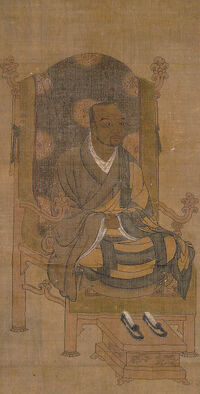
Won Hyo
Won-Hyo is an ITF pattern with 28 movements diagrammed as a capital I. It is named after the noted monk Won-Hyo who introduced Buddisim to the Silla Dynasty in the year 686 C.E.
Won-hyo (617 - 686) was one of the leading thinkers, writers and commentators of the Korean Buddhist tradition. With his life spanning the end of the Three Kingdoms period and the beginning of the Unified Silla, Wonhyo played a vital role in the reception and assimilation of the broad range of doctrinal Buddhist streams that flowed into the Korean peninsula at the time. Wonhyo was most interested in, and affected by Tathāgatagarbha , Yogācāra and Hwaom thought. However, in his extensive scholarly works, composed as commentaries and essays, he embraced the whole spectrum of the Buddhist teachings.
Videos[]
ITF Taekwon-do forms often come in two styles: Sine Wave and non-Sine Wave. In either case, the basic movements are the same. The difference is in the "up and down" motion that's used (or not), the rhythm of the movements, and the breathing. See main article Sine Wave for additional details.
Why was this video chosen for use on this wiki? Do you have a better video? Please see Video Guidelines before replacing this video with a better one.
| Sine Wave | Non-Sine Wave |
|---|---|

|

|
Diagram[]
Written Instructions[]

The lines of Won-Hyo (student view)
Here on this wiki, the wording used to describe this form deviates from the conventional wording historically used to describe the form. This was done to facilitate wiki-style links to the names of associated techniques. To view the conventional wording, see ITF Forms Summary Description.
- Ready Posture: Closed Ready Stance Type A
- 1. Step the left foot toward B into a Right L-Stance (i.e., left foot forward) facing B. Twin Forearm Block.
- 2. Execute a Right High Knifehand Inward Strike to B, while bringing the left side fist in front of the right shoulder, maintaining a Right L-Stance (i.e., left foot forward) facing B.
- 3. Execute a Left Middle Punch to B, sliding the left foot toward B into a Left Fixed Stance facing B.
- 4. Bring the left foot to the right foot, then step the right foot toward A, forming a Left L-Stance (i.e., right foot forward) facing A. Twin Forearm Block.
- 5. Execute a High Inward Strike to A, while bringing the right side fist in front of the left shoulder, maintaining a Left L-Stance (i.e., right foot forward) facing A.
- 6. Execute a Right Middle Punch to A, sliding the right foot toward A into a Right Fixed Stance facing A.
- 7. Bring the right foot to the left foot, then turn the face toward D, pulling the left foot into a right Bending Ready Stance Type A toward D.
- 8. Execute a Left Middle Side Piercing Kick to D.
- 9. Lower the left foot to D into a Right L-Stance (i.e., left foot forward) facing D. Middle Knifehand Guarding Block to D.
- 10. Step the right foot toward D into a Left L-Stance (i.e., right foot forward) facing D. Knifehand Guarding Block to D.
- 11. Step the left foot toward D into a Right L-Stance (i.e., left foot forward) facing D. Middle Knifehand Guarding Block to D.
- 12. Step the right foot toward D into a Right Walking Stance facing D. Right Middle Straight Fingertip Thrust to D.
- 13. Step the left foot toward E turning counterclockwise to form a Right L-Stance (i.e., left foot forward) facing E. Twin Forearm Block.
- 14. Execute a Right High Knifehand Inward Strike to E, while bringing the left side fist in front of the right shoulder, maintaining a Right L-Stance (i.e., left foot forward) facing E.
- 15. Execute a Left Middle Punch to E, sliding the left foot toward E into a Left Fixed Stance facing E.
- 16. Bring the left foot to the right foot and then Step the right foot toward F, forming a Left L-Stance (i.e., right foot forward) facing F. Twin Forearm Block.
- 17. Execute a Left High Knifehand Inward Strike to F, while bringing the right side fist in front of the left shoulder, maintaining a Left L-Stance (i.e., right foot forward) facing F.
- 18. Execute a Right Middle Punch to F, sliding the right foot toward F into a Right Fixed Stance facing F.
- 19. Bring the right foot to the left foot and then step the left foot toward C into a Left Walking Stance facing C. Right Inner Forearm Circular Block to CF.
- 20. Execute a Right Low Front Snap Kick to C, keeping the position of the hands as they were in 19.
- 21. Lower the right foot to C into a Right Walking Stance facing C. Left Middle Punch to C.
- 22. Execute a Left Inner Forearm Circular Block to CE, while maintaining a Right Walking Stance facing C.
- 23. Execute a Left Low Front Snap Kick to C, keeping the position of the hands as they were in 22.
- 24. Lower the left foot to C into a Left Walking Stance facing C. Right Middle Punch to C.
- 25. Turn the face toward C into a left Bending Ready Stance Type A toward C.
- 26. Execute a Left Middle Side Piercing Kick to C.
- 27. Lower the right foot on line CD, then step the left foot toward B, turning counterclockwise to form a Right L-Stance (i.e., left foot forward) facing B. Middle Guarding Block to B.
- 28. Bring the left foot to the right foot, then Step the right foot toward A into a Left L-Stance (i.e., right foot forward) facing A. Middle Guarding Block to A.
- End: Bring the foot back to the ready position.
ITF Color-Belt Forms[]
The other forms in the ITF-series of Color Belt forms are:
- 10th gup - no form, just basic exercises: Four Direction Punch and Block
- 9th gup - Chon-Ji (19 movements)
- 8th gup - Dan-Gun (21 movements)
- 7th gup - Do-San (24 movements)
- 6th gup - Won-Hyo (28 movements)
- 5th gup - Yul-Gok (38 movements)
- 4th gup - Joong-Gun (32 movements)
- 3rd gup - Toi-Gye (37 movements)
- 2nd gup - Hwa-Rang (29 movements)
- Basic exercise at 2nd gup: Four Direction Thrust
- 1st gup - Choong-Moo (30 movements)
References[]
The primary reference is:
The following websites are also particularly good online references for ITF-style taekwondo:
